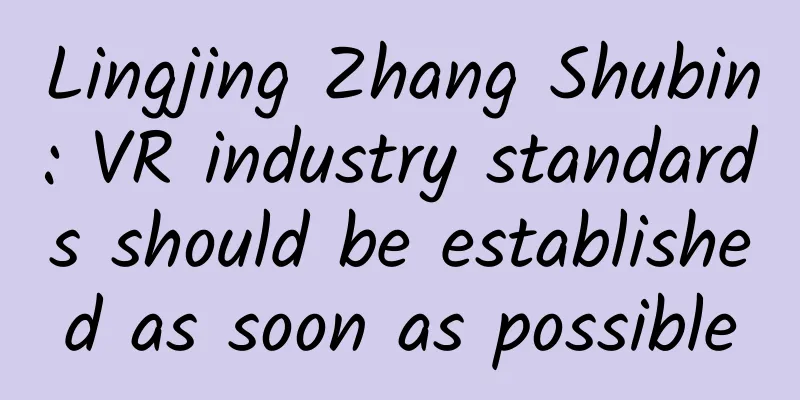Lingjing Zhang Shubin: VR industry standards should be established as soon as possible

|
According to the news, iQIYI VR Summit was successfully held in Shangfang Garden on the afternoon of July 26. A special report was conducted on this event. At the summit, Lingjing CEO Zhang Shubin delivered a speech, briefly reviewing the development history of Lingjing and especially raising the issue of standards in the VR industry. Zhang Shubin believes that currently, software and hardware developers are fighting on their own, and the constant adaptation process prolongs the development cycle and occupies unnecessary resources. Therefore, it is necessary to establish a compatible solution to accelerate the improvement of user experience.The following is the transcript of Zhang Shubin's speech: Good afternoon, everyone. This afternoon I will bring you two products of Lingjing and some issues I hope to exchange with the hardware and software industry. Because when I first received the notice for this meeting, it was said to be a salon with 20 to 30 people. I didn't prepare a PPT at that time. Maybe this is an exchange activity, some exchanges in the industry about technology, products, and the market, but so many people came today, and they all asked me to prepare some PPTs, talk about some practical things, and talk about our ideas about products, the industry, and future development. I prepared a PPT temporarily. In fact, I was also thinking about what practical things I would talk about this afternoon? For the industry leaders and colleagues who are doing well in the industry to discuss together. Let me briefly introduce what Lingjing does? We are actually a startup team. The team was established in April 2014. From a few people at the beginning to more than 30 people now, we are still a startup team, still very small. At present, our team has about 30 people, mainly in hardware R&D, software R&D, and there are some teams working together in the market and operations. Our first product was the Lingjing Xiaohei, an all-in-one device. When we first came into contact with VR and the entire industry, our understanding of VR was that we hoped that this product would be very convenient for users, and that it would be easy to get in their hands without any wires. At that time, we entered the VR market from the direction of an all-in-one device, not a PC device like Oculus. When we were working on the all-in-one machine, we considered that it was not enough to just have the hardware as a device. We also needed a VR ROM. We just did the split screen, and also the design and operation next to the system. So for this product, we actually made some attempts in terms of software and hardware. These attempts may be insignificant in the future, but they are very important for the industry and the user experience. We positioned it as a developer version for early hardware and software developers to provide a VR all-in-one development product. This product is still based on a mobile tablet and is not connected to a PC or a mobile phone, but it is a hardware device based on the Android VR all-in-one application platform. We plan to launch this product to the market in the second half of this year. When we first made the product, it was indeed a new hardware product, and this product was made when the hardware and software were very immature. Our Lingjing Xiaobai product was launched much later than Xiaohei. It is a VR box based on mobile phones. This product was officially launched in the market in May of this year and crowdfunded. In fact, when we launched this product, we didn’t have any special expectations for it. We were not sure how much it would sell, how popular it would be with users, and what kind of user feedback it would have. However, after launching it to the market, we did see that users in the market had high expectations for this kind of product. This product sold more than 14,000 units on the Taobao platform and received more than 2 million yuan in revenue. This result is still good in the industry, but with the launch of the product, including After users get their hands on the products, they find many problems. These problems are what I want to talk about and I hope to discuss some cooperation with hardware and software platforms. We hope that the next products and the next experience will be accepted by more users when they get them, and that they can use them for a long time and form repeated use, repeated purchase and repeated payment. Now, whether in the industry or outside the industry, people’s satisfaction with the products is relatively low. In fact, I think it will take some time to polish the products, including American products and Chinese products, to reach a level that users can accept, like and reuse. I mentioned earlier that I think the VR industry is huge. So many colleagues came here today, whether they are VR hardware teams, giants of video websites, or developers of some game companies. In fact, everyone has seen that the VR industry is a very large industry. There are many opportunities and chances, but there are also many challenges. Just now, Mr. Xu, who spoke earlier, also introduced that in the VR industry, we are now facing a lot of difficulties and challenges in technology, display technology, processor technology, and integrated experience technology. I think these difficulties and challenges will be solved with the development of time, but whether users can accept such a time, whether users can accept such products now, I think we actually have a very big question mark, including the user's tolerance and tolerance are actually relatively low. The next generation platform, I think this focus has been on the huge market and opportunities after the mobile phone and PC by many domestic and foreign peers. Its imagination, its market size, and its boundaries cannot be measured and evaluated by some mature markets we see now. This market is very large, and we dare not imagine how large it is. However, from the perspective of human desires and needs, everyone hopes to have a very big dream, and the dream can be realized in reality. Whether it is the dreams we have had before, or the game scenes or life scenes that we have never imagined before, they can all be formed in the virtual world. So I think the previous games and the previous entertainment industry were actually based on our desires. VR provides such an environment, the hardware environment, and the software environment to help us realize it, so I think this industry will be the ultimate platform in the future. It is still in the early stage. The problem of display graininess depends on the development of display technology to solve the display problem. The interaction is not friendly. VR does not have a real interactive method that can satisfy users and developers in the industry. Therefore, we think that the interaction is not friendly and is also a very big problem that needs to be solved urgently. Including the wearing comfort experience is also very poor, very heavy. In such an environment in 2015, everyone is used to smartphones, very thin mobile devices, and very fast networked devices. After seeing VR helmet-type devices, everyone's reaction is actually resistance. According to the feedback from many users we have contacted, it is too heavy. It is possible in the next three to five years, but how to make it lighter is also a very important problem we face. There is also the problem of dizziness. Mr. Xu specifically talked about some technical discussions on dizziness. It naturally overcomes dizziness, and all hardware problems can be solved. We are currently exploring the hardware experience, and we are constantly working hard to move forward. However, I think there is always a core problem that bothers our hardware startup team or future users and developers in the industry, which is content. The content is scarce, the quality of the content is uneven, and the way the content is presented is because the requirements for VR content are actually higher than those of previous mobile phone platforms and PC platforms. Panoramic and interactive technologies are basically not difficult for existing developers, but the development cost and development cycle are relatively challenging in the early stages of the industry. As a hardware manufacturer, we are now facing a big problem. After we have good equipment and users, the first reaction of users is, "Sell me your equipment, and I will play and use it." Therefore, for us in the industry, we communicate with our peers about how to make good content. As a hardware manufacturer, we are powerless. Today, as the platform provided to us by General Manager Zheng, large platforms have natural advantages in this regard. Large platforms also have such technology to open up. We hope that on the next generation of platforms, based on a good ecology, with the help of the current very mature software development technology, we can quickly produce some high-quality content. The current situation of the industry is that the mobile phone industry has spawned a large number of high-quality mobile platform developers. According to Unity data, there are approximately 1.5 million developers who are able to develop high-quality content for VR platforms. There are 4 million Android developers who can also transition very well to VR development. In the current very fierce environment, the survival status of mobile developers is also very difficult. How to make such a large industry as VR accommodate more developers switching from mobile platforms is actually the most common problem of our smart hardware or VR hardware or VR software platform. There is a market, there are user needs, there are developer capabilities, but how to connect them together is actually a very realistic problem, and it is a very specific problem for the future development of the industry. So, in the current problems encountered in our industry, I saw that iQiyi's APP was also sent to me. Based on the adaptation of Xiaobai, a simple experience was made, but the problem found was that iQiyi's APP projector was not particularly good, but there was not much distortion in the content. We have such a special algorithm, but how to connect with iQiyi, and how to connect iQiyi with Sohu's Youku, Tudou and even LeTV. This is the same problem facing hardware developers and software developers. Where are the users, there are many devices and APPs, there is no unified standard and no unified development method. In fact, this is an extremely wasteful development resource for software developers. It is a very realistic problem that needs to be constantly connected, because the interests of developers lie in how I can use an APP to adapt to more devices. We hope that our devices will be used by enough users. This problem is very realistic. At that time, we actually recommended users who can use Oculus. We helped him recommend some better content for users, but it may not be enough, including iQiyi's content, but the problem is that iQiyi's content is not well adapted on Lingjing's devices. What should I do? What if Lingjing's users don't sell enough content to customers? This problem is particularly detrimental to the user experience for users in the small market where there are already about 500,000 VR hardware devices. The experience is indeed not good enough. Now there is another problem. Our software developers and hardware developers are all working independently. They want to come up with some standards, but this is very difficult. I believe that it is impossible for iQiyi's platform to take over this market alone, and it is even more impossible for a company like our small team of 30 people. So I hope that we can do something together in the early stage of the industry to help promote the industry, help market education, and help user experience. Today, I would like to use this platform to throw out a brick to attract some jade. I hope that hardware manufacturers and software manufacturers will have a chance to sit down together to discuss how we can build a compatible solution with each other, provide some things in hardware to software developers, and provide some algorithms to developers. Developers can develop an APP that is suitable for multiple application platforms and as many software platforms as possible to give the user experience the best. This is the biggest help that may be possible for the industry. Now in this industry, we ourselves can provide high-quality content, but the level of high-quality experience is not enough. In fact, in the early days, users would really curse this industry. The product is so good, but the experience is not good enough. The user may not come next time. What I can think of is that in terms of software, can we all work together to customize a development process for developers, provide some hardware technical standards for developers, and even provide some input device development methods, access methods and operation methods for developers, so that developers can better develop high-quality content, truly serve developers, and let developers develop good content to serve VR users. If this alliance can really be established, it will definitely not be led by our small team, but by everyone or these giants. What we participate in should be a non-profit alliance-style third-party thing, so that everyone's interests and the interests of users can be protected in it, and our products can be accepted by more users. Finally, I want to say that the VR market is huge, but the industry is still small. We hope to work together to make the VR experience better. Thank you! As a winner of Toutiao's Qingyun Plan and Baijiahao's Bai+ Plan, the 2019 Baidu Digital Author of the Year, the Baijiahao's Most Popular Author in the Technology Field, the 2019 Sogou Technology and Culture Author, and the 2021 Baijiahao Quarterly Influential Creator, he has won many awards, including the 2013 Sohu Best Industry Media Person, the 2015 China New Media Entrepreneurship Competition Beijing Third Place, the 2015 Guangmang Experience Award, the 2015 China New Media Entrepreneurship Competition Finals Third Place, and the 2018 Baidu Dynamic Annual Powerful Celebrity. |
<<: Crunchbase: 40% of the top 30 AI companies with the most funding are from China
>>: Creating the future with data T11 2018 explores the development of new smart cities
Recommend
Six things you need to know before developing your first app
[[143903]] My first app was terrible. In fact, it...
Chinese mobile phone manufacturers should stop focusing on chips
Recently, the news that Chinese mobile phone manu...
Analysis of 3 high-conversion information flow advertising cases
Today I bring you several excellent information f...
Lanzhou Coffee Shop Mini Program Function, How much does it cost to develop a coffee shop WeChat mini program?
Coffee is a symbol of refined life. The developmen...
Tips for writing promotional plans!
1. What is a promotion plan? Before we know how t...
Behind Jia Yueting's car-making crisis: the race between "barbarians" and time
"The vision is beautiful, but making cars is...
Ultra-high voltage provides one less excuse for not doing homework!
Vocabulary Ultra-high voltage Potential safety ha...
China Automobile Dealers Association: Trends in passenger car market segments and main models in September 2021
In September, manufacturers' wholesale sales ...
How to acquire accurate users and achieve maximum conversion through SEO, SEM and WeChat public account operation
How to use SEO technology to double the website&#...
Apple AR is absent again, and domestic consumer AR brands support industry confidence
At 1:00 a.m. Beijing time on September 8, Apple h...
How to create a super user? Let’s clarify 3 points first!
Creating super users is not just a slogan, but a ...
Mitsubishi China recalls imported ASX and Pajero Sport
Recently, Mitsubishi Motors Sales (China) Co., Lt...
How to create a lucky draw app for WeChat official account? How much does it cost to create a WeChat lottery app?
Before we know it, another year has passed, and m...
It’s not worse than a camera. How to take high-quality photos with a mobile phone?
Compared with SLR cameras, mobile phone photograph...









